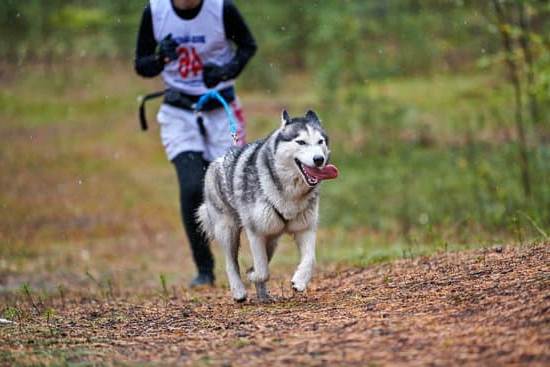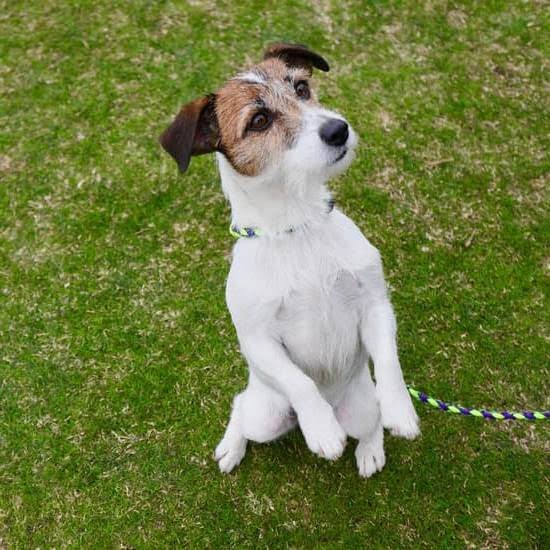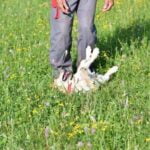Does your dog jump on the door every time someone comes over? Or maybe they leap up out of excitement when it’s time for a walk? Learning how to train your dog not to jump on doors can improve their behavior and make interactions with visitors much more pleasant.
Many pet owners struggle with this issue, but there are effective methods for addressing it. Understanding why dogs jump on doors is the first step towards finding a solution. By delving into the reasons behind this behavior, you can tailor your training approach to fit your dog’s specific needs.
In this article, we’ll explore the importance of training your dog not to jump on doors and provide practical advice for assessing your dog’s behavior and habits. We’ll also discuss positive reinforcement training methods, the role of consistency and patience in training, using commands and cues to prevent jumping on doors, as well as redirecting your dog’s energy and behavior.
By following our tips, you can effectively address this common behavioral problem and strengthen the bond with your furry friend.
The Importance of Training Your Dog Not to Jump on Doors
Training your dog not to jump on doors is an important aspect of their overall behavior and obedience. While it may seem harmless at first, door jumping can be a nuisance and even pose a safety risk for both your pet and anyone entering your home. By understanding the reasons behind this behavior and following proper training techniques, you can effectively address and correct this issue.
One of the main reasons why dogs jump on doors is due to their natural instincts and excitement. When they hear someone approaching or when they are eager to go outside, they may jump up as a way of expressing their enthusiasm. It’s essential to recognize that this behavior is often a sign of pent-up energy or a lack of proper training.
To tackle this issue, it’s crucial to assess your dog’s behavior and habits in different scenarios. Observe when they tend to jump on doors and try to identify any specific triggers or patterns. By understanding their actions, you can implement targeted training methods to redirect their behavior in a positive direction.
Positive reinforcement training methods are highly effective in teaching your dog not to jump on doors. This involves rewarding them for good behavior using treats, praise, or affection. When your dog refrains from jumping on the door, be sure to acknowledge and encourage this positive conduct. Through consistent training and patience, you can help your pet understand the desired behavior while building a strong bond based on trust and respect.
Assessing Your Dog’s Behavior and Habits
When it comes to addressing the issue of dogs jumping on doors, one of the most crucial steps is to assess your dog’s behavior and habits. Understanding why your dog engages in this behavior will help you tailor your training approach to effectively address it.
Dogs may jump on doors for a variety of reasons, such as seeking attention, wanting to go outside, or simply out of excitement. By observing when and why your dog jumps on doors, you can better determine the underlying cause and devise a targeted training plan.
Assessing your dog’s behavior also involves looking at their overall obedience and impulse control. If your dog has a tendency to exhibit hyperactive or impulsive behavior in other situations, it may indicate the need for more comprehensive training to address these underlying issues. Additionally, considering factors such as age, breed, and previous experiences can provide valuable insight into your dog’s jumping tendencies.
To effectively address door jumping behavior, it is important to establish a consistent and structured training routine. Positive reinforcement techniques have been proven to be effective in modifying undesirable behaviors in dogs. This involves rewarding your dog for displaying the desired behavior (not jumping on the door) with treats, praise, or toys. By consistently reinforcing good behavior, you can encourage your dog to understand that not jumping on doors results in positive outcomes.
In addition to positive reinforcement methods, using commands and cues can help deter your dog from jumping on doors. Teaching commands like “sit” or “stay” can provide an alternative outlet for their energy and redirect their focus away from door jumping. Consistency and patience are key when implementing these techniques, as it may take time for your dog to learn and adapt to new behaviors.
| Assessing Your Dog’s Behavior | Importance of Training |
|---|---|
| Understanding why your dog jumps on doors | Establishing consistency and structured routine |
| Evaluating overall obedience and impulse control | Positive reinforcement training methods |
| Considering factors such as age and breed | Using commands and cues |
By taking the time to assess your dog’s behavior and habits while implementing positive reinforcement techniques and consistent training methods, you can effectively train your dog not to jump on doors. However, if despite these efforts the issue persists due to potential underlying issues or behavioral problems that require professional guidance, seeking help from a certified animal behaviorist or trainer may be necessary for long-term success in correcting this behavior.
Positive Reinforcement Training Methods
Using Treats and Rewards
One of the most effective ways to train your dog not to jump on doors is through positive reinforcement. This involves using treats, praise, and rewards to encourage good behavior. When your dog refrains from jumping on the door, make sure to immediately reward them with a treat or verbal praise. This will help them associate the act of not jumping with receiving something they enjoy, making it more likely that they will continue this behavior in the future.
Clicker Training
Another method of positive reinforcement training is clicker training. This involves using a handheld clicker device that makes a distinct sound when pressed. Whenever your dog avoids jumping on the door, use the clicker to mark the behavior and then reward them with a treat. Over time, your dog will learn to associate the sound of the clicker with doing the right thing and receiving a reward, helping to eliminate their jumping behavior.
Consistency in Training
Consistency is key when using positive reinforcement training methods. Make sure that everyone in your household is on board with the training plan and understands how to reinforce good behavior consistently. Inconsistencies in training can confuse your dog and make it harder for them to understand what is expected of them. By being consistent in rewarding your dog for not jumping on doors, you can effectively communicate the desired behavior to them.
By utilizing these positive reinforcement training methods, you can effectively teach your dog not to jump on doors while strengthening your bond with them at the same time. Remember that every dog is different and may respond differently to various training techniques, so be patient and adaptable as you work towards correcting this unwanted behavior.
Consistency and Patience in Training
Training your dog not to jump on doors requires consistency and patience to be successful. It’s important to remember that changing your dog’s behavior takes time and a consistent approach to training.
Consistency means ensuring that everyone in your household is on the same page when it comes to training your dog not to jump on doors. This means using the same commands, cues, and methods consistently so as not to confuse your pet. If one person allows the behavior while another tries to correct it, your dog will become confused about what is and isn’t acceptable.
Patience is also key when training your dog. It may take time for them to fully understand what you want from them, so it’s important not to get frustrated or give up. Positive reinforcement methods, such as treats and praise, are effective but require patience as well. Your dog needs time to associate their actions with the consequences and rewards they receive.
Consistency and patience in training can be challenging at times, but it is essential for teaching your dog not to jump on doors. Remember that every step forward, no matter how small, is progress in the right direction. Stay patient, stay consistent, and you will see positive results in due time.
By understanding the principles of consistency and patience in training, you’ll be better equipped to tackle the issue of door jumping with your furry friend effectively. Keep these principles in mind as you work with your pet toward more desirable behavior at home.
Using Commands and Cues to Prevent Jumping on Doors
When it comes to preventing your dog from jumping on doors, using commands and cues can be an effective method for training. One key command that can be useful is the “off” command, which teaches your dog to get off the door or any other surface they are jumping on. By consistently using this command and rewarding your dog when they comply, you can reinforce the behavior of not jumping on doors.
Another cue that can be helpful is teaching your dog to go to a designated spot, such as a bed or mat, when someone comes to the door. You can use a specific word or phrase to signal this behavior, such as “place” or “go to your spot.” By practicing this cue with your dog whenever the doorbell rings or someone knocks, you can redirect their energy away from jumping on the door and towards a more appropriate behavior.
It’s important to remember that consistency is key when using commands and cues to prevent jumping on doors. Every time your dog jumps on the door, it’s essential to use the same command or cue and follow through with positive reinforcement when they respond appropriately. This helps your dog understand what is expected of them and reinforces the desired behavior.
By utilizing these commands and cues, along with positive reinforcement training methods, you can effectively train your dog not to jump on doors. It may take time and patience, but with consistent training and practice, you will see improvement in your dog’s behavior.
| Commands/Cues | Description |
|---|---|
| Off Command | Teaches the dog to get off the door or other surfaces |
| Designated Spot Cue | Teaches the dog to go to a specific place when someone comes to the door |
| Consistency | Using the same command or cue every time and following through with positive reinforcement |
Redirecting Your Dog’s Energy and Behavior
Exercise and Mental Stimulation
One way to redirect your dog’s energy is by ensuring they receive enough physical exercise and mental stimulation throughout the day. Take your dog for regular walks, engage in interactive play, or provide puzzle toys to keep their mind occupied. A tired and mentally stimulated dog is less likely to exhibit excessive jumping behaviors.
Teach Alternative Behaviors
Another effective method for redirecting your dog’s energy is by teaching them alternative behaviors that are incompatible with jumping on doors. For example, you can train them to go to their designated resting spot or perform a specific command when someone arrives at the door. By giving your dog a task to focus on, you can redirect their attention away from jumping.
Provide Environmental Enrichment
Creating an enriched environment for your dog can also help redirect their energy and prevent door jumping. Consider introducing new toys, rotating existing toys, or setting up interactive games within the home. Additionally, providing access to a variety of safe chew toys can help alleviate any anxious or destructive behavior that may contribute to door jumping.
By implementing these strategies for redirecting your dog’s energy and behavior, you can effectively deter them from jumping on doors while promoting positive alternatives for their natural instincts and tendencies.
Tips for Reinforcing Good Behavior
Training your dog not to jump on doors can be a challenging task, but it is essential for their safety and the safety of others. Here are some tips for reinforcing good behavior in your canine companion:
- Use positive reinforcement: When your dog successfully refrains from jumping on the door, reward them with treats, praise, or playtime. This will help them understand that this behavior is desirable.
- Consistency is key: Be consistent in your training approach. If you allow your dog to jump on the door sometimes and not others, they will become confused and may continue the unwanted behavior.
- Ignore the jumping: When your dog jumps on the door, do not give them any attention. Turn away from them or leave the room if necessary. This teaches them that jumping will not get them what they want.
In addition to these tips, it’s important to remember that every dog is different, and what works for one may not work for another. Be patient and stay calm during the training process, as getting frustrated with your dog can hinder their progress.
Remember to also provide alternative outlets for your dog’s energy, such as regular exercise and mental stimulation. A tired and mentally stimulated dog is less likely to engage in unwanted behaviors like jumping on doors.
By using these tips for reinforcing good behavior and staying committed to training, you can effectively teach your dog not to jump on doors and ensure a harmonious relationship with your pet.
Addressing Potential Underlying Issues Causing Door Jumping
When your dog continuously jumps on doors, it may be a sign of an underlying issue that needs to be addressed. Understanding the reasons why your dog displays this behavior can help in effectively training them not to jump on doors.
There are several potential underlying issues that could cause door jumping in dogs, such as separation anxiety, lack of physical exercise, boredom, or seeking attention. It’s important to assess your dog’s overall behavior and habits to determine the root cause of their door jumping tendencies.
- Separation Anxiety: If your dog tends to jump on doors when you leave the house, they may be experiencing separation anxiety. This can be addressed through gradual desensitization exercises and providing comfort items while you’re away.
- Lack of Exercise: Dogs with excess energy may resort to jumping on doors as a means of releasing pent-up energy. Providing regular physical exercise and mental stimulation can help redirect their energy towards more appropriate activities.
- Boredom: Dogs that are bored or understimulated may engage in attention-seeking behaviors like jumping on doors. Offering interactive toys, games, and obedience training can keep them occupied and less likely to jump on doors out of boredom.
By identifying and addressing these potential underlying issues causing door jumping, you can effectively train your dog not to engage in this behavior through positive reinforcement, consistency, and patience. If you find that the door jumping persists despite your efforts, seeking professional help from a certified dog trainer or behaviorist may be necessary for further evaluation and guidance.
Seeking Professional Help if Needed
In conclusion, training your dog not to jump on doors is an essential aspect of responsible pet ownership. Understanding the reasons behind this behavior, such as excitement, anxiety, or a need for attention, is crucial in addressing and correcting it. It’s important to assess your dog’s behavior and habits to determine the best approach for training.
Positive reinforcement methods, consistency, and patience are key elements in teaching your dog not to jump on doors. Using commands and cues, along with redirecting your dog’s energy and behavior towards alternate activities, can help prevent door jumping. Additionally, reinforcing good behavior with rewards and praise will encourage your dog to continue exhibiting the desired actions.
While most cases of door jumping can be resolved with proper training and patience, it’s important to address any potential underlying issues that may be contributing to this behavior. If despite consistent efforts your dog continues to jump on doors, seeking professional help from a certified dog trainer or behaviorist may be necessary. These experts can provide valuable insights and techniques tailored specifically to your dog’s needs and behavior.
Remember that every dog is different, so what works for one may not work for another. Training takes time and commitment, but with the right approach and resources, you can successfully teach your dog not to jump on doors. By being patient, consistent, and using positive reinforcement methods,you can help create a well-behaved canine companion.
Frequently Asked Questions
How Do I Train My Dog Not to Jump on the Door?
Training your dog not to jump on the door involves consistent reinforcement of the desired behavior. This can include redirecting their attention, using positive reinforcement, and providing alternative activities to engage in when they’re at the door.
Why Do Dogs Jump on the Door?
Dogs may jump on the door for various reasons, such as excitement, anxiety, or a desire for attention. It could also be a learned behavior if they have been inadvertently reinforced for jumping in the past.
How Do You Teach a Dog Not to Jump?
Teaching a dog not to jump requires patience and consistency. Using commands like “sit” or “stay” can help redirect their focus and reinforce the desired behavior. Additionally, offering treats and praise when they display the appropriate behavior can be effective in teaching them not to jump.

Welcome to the blog! I am a professional dog trainer and have been working with dogs for many years. In this blog, I will be discussing various topics related to dog training, including tips, tricks, and advice. I hope you find this information helpful and informative. Thanks for reading!





